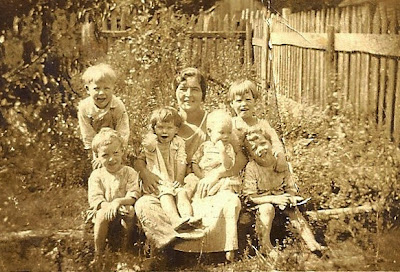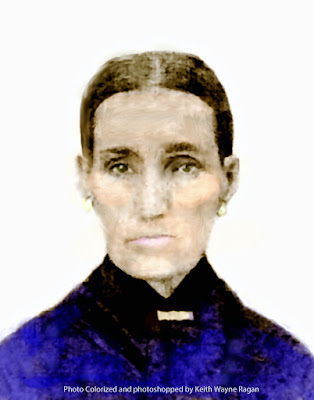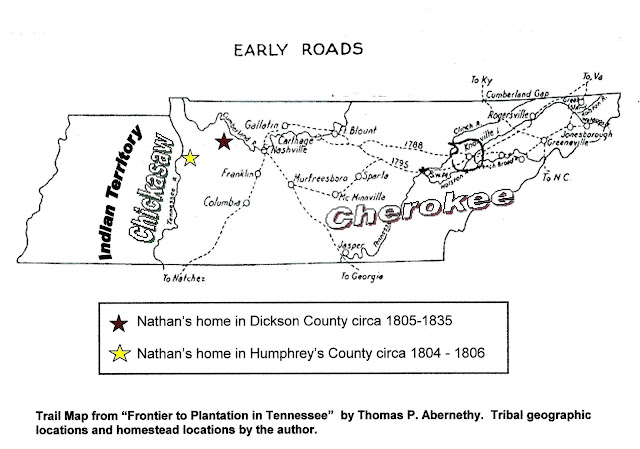Refections in Time--Momma's Apron
When Hilda Lorraine Dees McCafferty presented me with the photograph of Blanche Moore with the children of the Moore Community I was taken back with a longing, a wistfulness, and nostalgia for a time I hadn't even experienced. My eyes were not just riveted on the sheer happiness radiating from the face of my mother at approximately four years of age, but of the other children in the company of Blanche. And in Blanche, herself. It is easy to see the love there, each for the other, and that Blanche's care of the children that day was a labor of love.
Happy Times in Old Jibby. Photo circa 1924 in the Moore Community of Wayne, County, Missouri near Rucker/Ojibway. My uncle Clarence Madison (Bud) Wilson believes this photo was taken at the homestead of Daniel and Susan Moore, my Great-Grandparents. The young lady in the photograph, center, is the author of "Momma's Apron", Blanche Moore. The children are, Back row, L-R: Wilbur Eugene Dees (1919-1945) and Anna Marie Wilson (1916-1978). Wilbur gave his life defending his county, flag, and family in Germany in World War II. Front row, L-R: Francis Marion (Hank) Wilson (1918-1988), Vinita Mae Dees (1921-1999), Sylvia Wilson (1922-1986), and my mother, Iva Delores (Dee) Wilson (1920-1976).
I rifled through files to find the hand-written memoirs of Blanche that I had received from Aunt Mary Wilson Bazzell and found that Blanche's memories matched the joy of community and family that I had discovered in the smiling faces of the photograph. She was eloquent, and her love of her roots in the old Rucker/Ojibway era revealed intimate details of a life we could not imagine, of our ancestors raising families there in the former land of, and adjoining, John William Moore and Elizabeth (Eliza) Beary Moore.
I found commentary in the cursive scroll that provided an insight we rarely get doing genealogical research, of our ancestral grandmothers' life in general. The excerpt that I have chosen for this narrative is not on one of my own grandmothers, but just as well could be. It is a story told by Blanche of her mother, Malinda Jane Chatman (1881-1968). Malinda Jane Chatman and her sister Loudelphia (Lou) Ann Chatman married grandsons of William and Elizabeth Moore, Malinda to Charles Robert Nathaniel Moore and Lou to William Patrick Moore. The boys were the sons of William Dudley Moore, brother of Daniel, and Martha Alice Whitt.
Blanche Moore, to be specific, is my second cousin, one time removed. She was born 23 April, 1907 in the Moore Community of Wayne County, Missouri, granddaughter of William Dudley (Boots) Moore and Martha Alice Whitt Moore, and the daughter of the main subject of her writings in the narrative, Malinda Jane Chatman Moore and Charles Robert Nathaniel Moore.
Blanche married Lloyd Parsons Edwards in Belleville. Illinois, and they were living in St. Louis on the 1940 census. She died 16 August, 1979 in Granite City, Madison County, Illinois just across the river from St. Louis and is buried in St. John's Cemetery there. Blanche had one child of which I am aware at this time, Juanita J. Edwards, B: 1930.
These are her words, through the eyes of a child recalled with love in her declining years. I borrow her words to tell of a time long ago when the road in front of the Moore Spring was lined with houses and children playing, and men working the fields in front of Wet Fork Creek. And of our grandmothers working the long days nurturing, mending, laundering, cooking, and providing love and comfort and most importantly, strength and foundation to the families living in this rocky, terraced, remote geography of Wayne County. I call this simply, "Momma's Apron".
"This is the true story of my mother's old gingham apron.
I remember the old gingham apron my mother wore. She never did her work in the kitchen without her apron on. The apron was the last thing she put on in the morning and the first thing she took off at night. When she took off the old apron, that meant all her work was done and it was time for bed.
The apron extended well around her sides and tied in the back with a bow. Each apron had a large pocket. Everything about her apron served a purpose. If it was a bib apron, the bib was a place for safety pins which would be used for any emergency, such as replacing a missing button from our clothes. The bib was also nice for holding a needle and thread--just in case they were needed.
Most of mother's aprons were made of gingham or calico. The colors were dark so they wouldn't show soil easily. All were handmade. Sometimes, just to add a little fancy to them, Mother trimmed the edges with bias tape. There was always a light or white gingham apron called her Sunday apron which she wore when she had company.
In the kitchen Mother's apron was of great value. She would make it into a sort of basket by gathering up the hem in her hands. In this little basket she would bring in chips and kindling to start the fire in the kitchen stove. Then she would use the apron to fan the fire into a blaze. The apron might be used as a pot holder to lift the stove lid or open the oven door.
If anyone should come to door while mother was washing dishes, she would use the apron as a towel to dry her hands. I have seen her wipe the perspiration from her face with the apron after cooking a big meal over the hot stove. I can remember her using the apron to dry tears when the news came that some of her loved ones had died. When she was called or someone came after her in the night because someone was sick, she always took the time to get a clean apron as she went by the old dresser.
As a child, I would hide from strangers behind the folds of my mother's apron. I have seen her use her apron to hide her flushed cheeks when someone made an off-color remark. Yes, they knew how to blush in those days, although there were fewer reasons then.
Sometimes Mother used her apron to flag someone passing by to tell them about a sick neighbor or to send to town for something or to mail a letter. The apron shooed chickens out of the yard and garden as well as flies and children out of the kitchen. On cleaning day, the pocket of her apron served as a nice little trash can as she picked up hair pins and buttons. On wash day the pocket was a good clothespin bag. Sometimes she used the apron to wipe the clothesline before hanging out white clothes.
On Memorial Day every year my mother would pick an apron full of flowers and place them on the graves of friends and loved ones.
My mother gathered green beans, wild grapes, apples, and eggs with her apron. She used it to carry feed to the chickens and to transfer little baby chicks from the nest to the chicken coop. The apron was a good flyswatter for the old horsefly when she was milking the cow.
When Mama picked the feathers from geese and ducks for our pillows and feather beds, she used her apron to cover the feathers while picking the geese so the wind wouldn't blow the feathers away. On a cool day, the apron was just right to cover her arms while she stood in the doorway talking to a neighbor when she was leaving after a social call.
My mother felt that the old gingham apron was a part of her. I have heard her say "I am lost without my apron in the kitchen". I am sure if she could see the closets of many young mothers today, she would say, "My, my gals, that's more clothes than I ever saw in my whole life". But if all our clothes were put together they could never serve as many purposes as her old-fashioned gingham apron". --Blanche Edwards
I rifled through files to find the hand-written memoirs of Blanche that I had received from Aunt Mary Wilson Bazzell and found that Blanche's memories matched the joy of community and family that I had discovered in the smiling faces of the photograph. She was eloquent, and her love of her roots in the old Rucker/Ojibway era revealed intimate details of a life we could not imagine, of our ancestors raising families there in the former land of, and adjoining, John William Moore and Elizabeth (Eliza) Beary Moore.
I found commentary in the cursive scroll that provided an insight we rarely get doing genealogical research, of our ancestral grandmothers' life in general. The excerpt that I have chosen for this narrative is not on one of my own grandmothers, but just as well could be. It is a story told by Blanche of her mother, Malinda Jane Chatman (1881-1968). Malinda Jane Chatman and her sister Loudelphia (Lou) Ann Chatman married grandsons of William and Elizabeth Moore, Malinda to Charles Robert Nathaniel Moore and Lou to William Patrick Moore. The boys were the sons of William Dudley Moore, brother of Daniel, and Martha Alice Whitt.
Blanche Moore, to be specific, is my second cousin, one time removed. She was born 23 April, 1907 in the Moore Community of Wayne County, Missouri, granddaughter of William Dudley (Boots) Moore and Martha Alice Whitt Moore, and the daughter of the main subject of her writings in the narrative, Malinda Jane Chatman Moore and Charles Robert Nathaniel Moore.
Blanche married Lloyd Parsons Edwards in Belleville. Illinois, and they were living in St. Louis on the 1940 census. She died 16 August, 1979 in Granite City, Madison County, Illinois just across the river from St. Louis and is buried in St. John's Cemetery there. Blanche had one child of which I am aware at this time, Juanita J. Edwards, B: 1930.
These are her words, through the eyes of a child recalled with love in her declining years. I borrow her words to tell of a time long ago when the road in front of the Moore Spring was lined with houses and children playing, and men working the fields in front of Wet Fork Creek. And of our grandmothers working the long days nurturing, mending, laundering, cooking, and providing love and comfort and most importantly, strength and foundation to the families living in this rocky, terraced, remote geography of Wayne County. I call this simply, "Momma's Apron".
"This is the true story of my mother's old gingham apron.
I remember the old gingham apron my mother wore. She never did her work in the kitchen without her apron on. The apron was the last thing she put on in the morning and the first thing she took off at night. When she took off the old apron, that meant all her work was done and it was time for bed.
The apron extended well around her sides and tied in the back with a bow. Each apron had a large pocket. Everything about her apron served a purpose. If it was a bib apron, the bib was a place for safety pins which would be used for any emergency, such as replacing a missing button from our clothes. The bib was also nice for holding a needle and thread--just in case they were needed.
Most of mother's aprons were made of gingham or calico. The colors were dark so they wouldn't show soil easily. All were handmade. Sometimes, just to add a little fancy to them, Mother trimmed the edges with bias tape. There was always a light or white gingham apron called her Sunday apron which she wore when she had company.
In the kitchen Mother's apron was of great value. She would make it into a sort of basket by gathering up the hem in her hands. In this little basket she would bring in chips and kindling to start the fire in the kitchen stove. Then she would use the apron to fan the fire into a blaze. The apron might be used as a pot holder to lift the stove lid or open the oven door.
If anyone should come to door while mother was washing dishes, she would use the apron as a towel to dry her hands. I have seen her wipe the perspiration from her face with the apron after cooking a big meal over the hot stove. I can remember her using the apron to dry tears when the news came that some of her loved ones had died. When she was called or someone came after her in the night because someone was sick, she always took the time to get a clean apron as she went by the old dresser.
As a child, I would hide from strangers behind the folds of my mother's apron. I have seen her use her apron to hide her flushed cheeks when someone made an off-color remark. Yes, they knew how to blush in those days, although there were fewer reasons then.
Sometimes Mother used her apron to flag someone passing by to tell them about a sick neighbor or to send to town for something or to mail a letter. The apron shooed chickens out of the yard and garden as well as flies and children out of the kitchen. On cleaning day, the pocket of her apron served as a nice little trash can as she picked up hair pins and buttons. On wash day the pocket was a good clothespin bag. Sometimes she used the apron to wipe the clothesline before hanging out white clothes.
On Memorial Day every year my mother would pick an apron full of flowers and place them on the graves of friends and loved ones.
My mother gathered green beans, wild grapes, apples, and eggs with her apron. She used it to carry feed to the chickens and to transfer little baby chicks from the nest to the chicken coop. The apron was a good flyswatter for the old horsefly when she was milking the cow.
When Mama picked the feathers from geese and ducks for our pillows and feather beds, she used her apron to cover the feathers while picking the geese so the wind wouldn't blow the feathers away. On a cool day, the apron was just right to cover her arms while she stood in the doorway talking to a neighbor when she was leaving after a social call.
My mother felt that the old gingham apron was a part of her. I have heard her say "I am lost without my apron in the kitchen". I am sure if she could see the closets of many young mothers today, she would say, "My, my gals, that's more clothes than I ever saw in my whole life". But if all our clothes were put together they could never serve as many purposes as her old-fashioned gingham apron". --Blanche Edwards
Malinda Jane Chatman Moore





Hi, Blanche Moore Edwards was my mother. I have been researching my "roots" I just read that this blog is closing down? Is that correct? I am very interesting in making copies of my family info...I remember Bessie and a LOT of the names listed in some of the writings. I visited Rucker many time as as a young girl...Had contact with Jewell Moore (passed away at 106) all thru te years. I had attended many cemetery gatherings at top of him from the olds church & school house, until it was too hard for me to travel. If you see this can you contact me please?
ReplyDeletethat's cemetery at top of "hill"
ReplyDeleteI am not aware that this blog is closing down. However, I do know that several have reported that their domains here have expired and disappeared. I am descended from Daniel Moore, Bessie Moore, Delores Wilson Ragan. We still attend the August grave cleaning services at Rucker and make the trip to drink from the spring every year. Since you are family, you have my permission to copy but not publish or cause top be published any of the stories without my approval. Thanks for your comments.
ReplyDelete